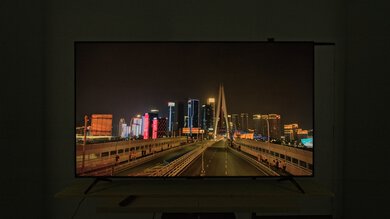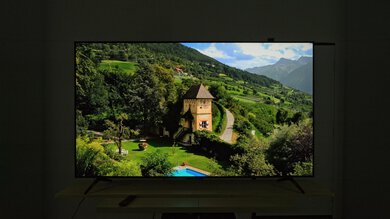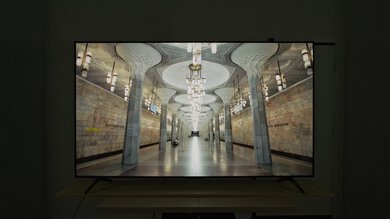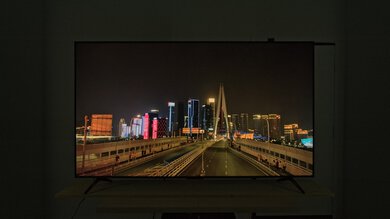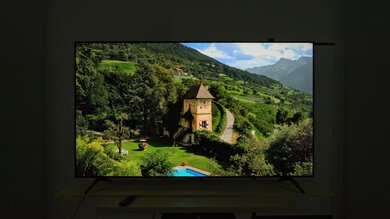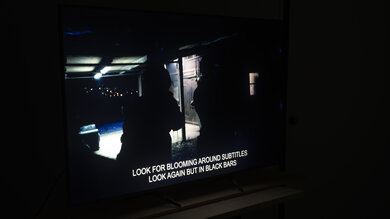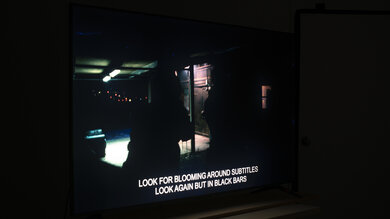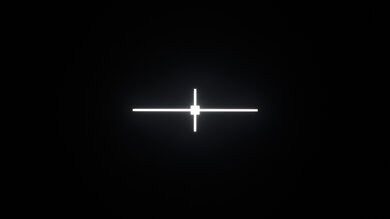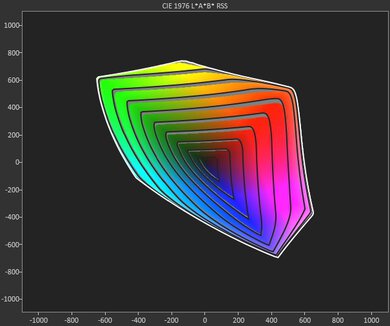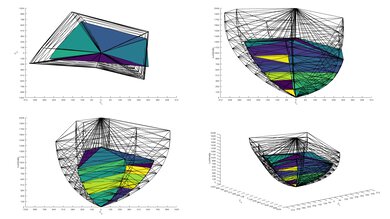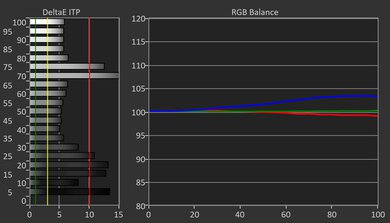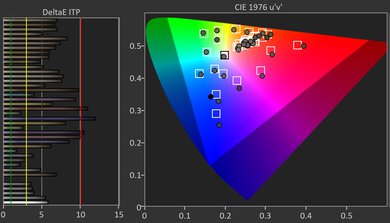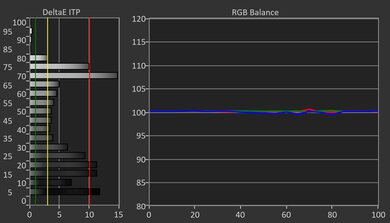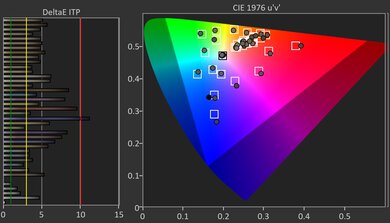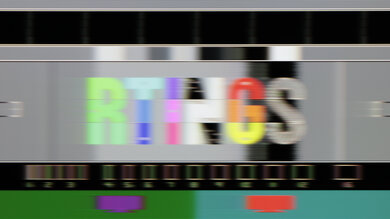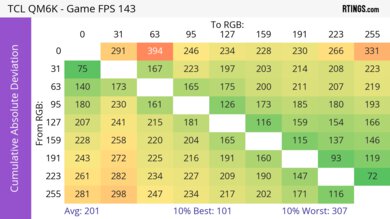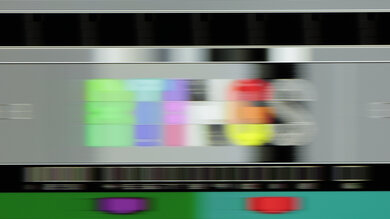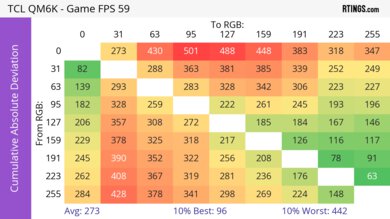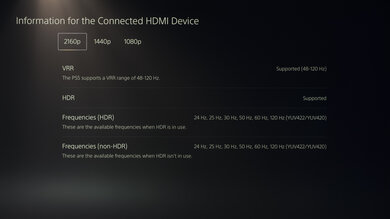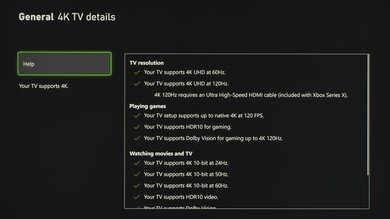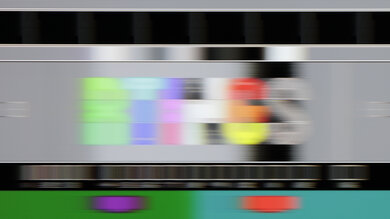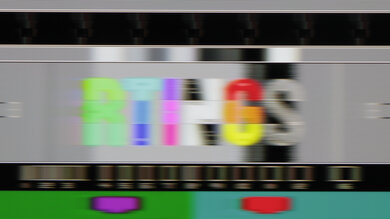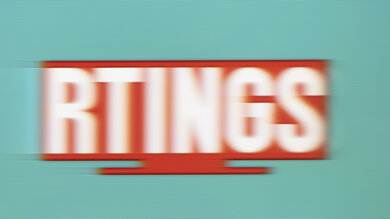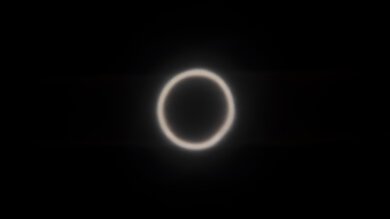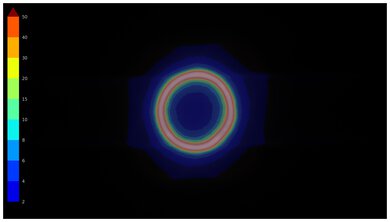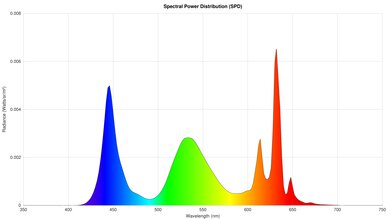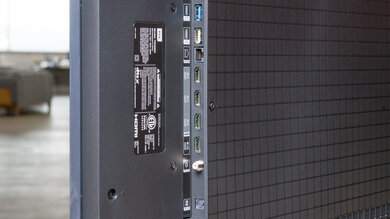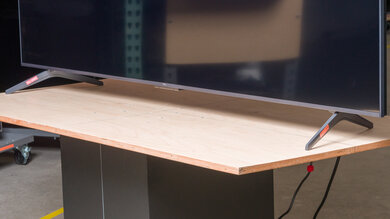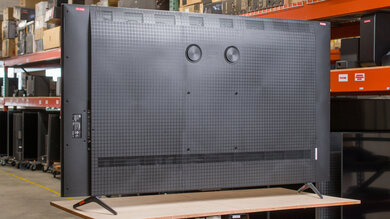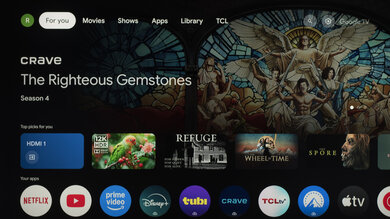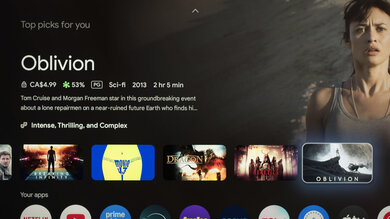The TCL QM6K is an entry-level TV released in 2025 and technically replaces the 2024 TCL Q6/Q651G QLED, although the newer model is a step up from the previous one due to its Mini LED panel and advanced gaming features, but at a higher cost. It supports both 4k @ 144Hz and 1080p @ 288Hz, with VRR, on its two HDMI 2.1 ports. It also has two HDMI 2.0 ports, one of which doubles as an eARC port with full Dolby and DTS advanced audio passthrough. The TV supports both Dolby Vision HDR and HDR10+ formats and runs version 12 of the popular Google TV smart interface, so it also has smart features like voice control and is loaded with a ton of streaming apps. We bought and tested the 75-inch model, but it's also available in a 55, 65, 85, and 98-inch size.
Our Verdict
The TCL QM6K is a well-rounded TV, even if it doesn't excel in any particular area. Its strongest suit is its very good gaming performance, helped by its very low input lag, high refresh rate support, and numerous gaming features. Visually, the TV doesn't impress, although its black levels are quite good due to its impressive contrast and good black uniformity. Unfortunately, there's more haloing around bright highlights than you'd like, but it's alright. Its HDR brightness is mediocre at best, so the TV doesn't provide an impactful HDR experience overall. Still, it's a decent choice for reference conditions due to those black levels, good HDR brightness accuracy, and low amount of stutter. It performs better in SDR content due to its high SDR peak brightness, which is enough to overcome some glare from brighter rooms, just as long as you avoid placing any lights directly facing the TV.
Very good black levels deliver deep blacks no matter the room context.
Very accurate in HDR and SDR.
Bright enough in SDR to overcome glare from indirect light sources.
HDMI 2.1 bandwidth, up to 4k @ 144Hz and 1080p @ 288Hz, and VRR support.
Too dim in HDR to provide a truly impactful HDR viewing experience.
Visible glare when placed directly opposite bright lights or windows.
Image degrades somewhat when viewed from extreme angles.
The TCL QM6K is a decent choice for a home theater setup, mostly due to its good black levels. Its contrast is impressive, and its black uniformity is good, so it delivers deep blacks in darker scenes, even if there's a bit more haloing around bright highlights than you'd like. Aside from that, the TV is decent but unimpressive. Its HDR color volume is alright and does the job, but colors aren't vibrant, although they're accurate. The TV is not nearly bright enough in HDR to deliver impactful HDR highlights. The TV's PQ EOTF tracking is quite good, however, so the TV mostly follows the content creator's intent when it comes to HDR brightness. There's also little noticeable stutter due to the TV's relatively slow response time.
Very good black levels deliver deep blacks no matter the room context.
Very accurate in HDR and SDR.
Follows the content creator's intent relatively well, if a tad overbrightened overall.
Little noticeable stutter.
Some noticeable haloing around bright highlights set on a dark background.
Too dim in HDR to provide a truly impactful HDR viewing experience.
The TCL QM6K is a decent choice for brighter rooms due to its good SDR brightness, which is high enough to overcome some glare in well-lit contexts. Unfortunately, the TV struggles with direct reflections, so it doesn't fare well in rooms with tons of lights directly facing it. The TV's colors are decent, but they're not impactful even if they are mostly accurate. Thankfully, the TV's black levels don't noticeably raise in brighter rooms.
Bright enough in SDR to overcome glare from indirect light sources.
Visible glare when placed directly opposite bright lights or windows.
The TCL QM6K is a satisfactory choice for sports. It's bright enough in SDR to overcome glare from brighter rooms but make sure that your lights aren't directly facing the screen as the TV struggles with direct reflections. Its image processing is decent, so it cleans up a bit of macro-blocking when you're watching sports through streaming services, although its upscaling doesn't quite manage to significantly clean up low-resolution content. Its colors are quite accurate in SDR, so your favorite team's jerseys look as they should, although the TV's SDR color volume isn't good enough to make them pop out of the screen. Its viewing angle is mediocre, so it's not the best choice for a wide seating arrangement; try to keep your friends seated directly in front of the TV for the best possible experience.
Bright enough in SDR to overcome glare from indirect light sources.
Impressively accurate in SDR content.
Visible glare when placed directly opposite bright lights or windows.
Image degrades somewhat when viewed from extreme angles.
If you're looking for a performance-driven gaming TV, then the TCL QM6K is a solid pick. It's very responsive due to its low input lag and its support for both 4k @ 144Hz and 1080p @ 288Hz, alongside a wide VRR range. Its pixel transitions are decently fast at the higher refresh rates, especially for an LED TV. Unfortunately, the TV isn't quite as impressive when it comes to image quality, especially in HDR, where it's too dim to provide a truly impactful experience. Its black levels are good, however, even if there's some noticeable haloing around bright highlights, and its colors are accurate, but they're not very vibrant.
Extremely low input lag.
Very good black levels deliver deep blacks no matter the room context.
HDMI 2.1 bandwidth, up to 4k @ 144Hz and 1080p @ 288Hz, and VRR support.
Some noticeable haloing around bright highlights set on a dark background.
Too dim in HDR to provide a truly impactful HDR viewing experience.
The TCL QM6K's brightness is alright. Its HDR brightness is mediocre, so it struggles to display bright HDR highlights with gusto. It fares much better in SDR content, where the TV is bright enough to overcome some glare in brighter rooms.
Bright enough in SDR to overcome glare from indirect light sources.
Too dim in HDR to provide a truly impactful HDR viewing experience.
The TCL QM6K's black level is good. Its contrast is impressive, alongside good black uniformity, leading to deep blacks in dark scenes when bright highlights are present. Unfortunately, its lighting zone precision is okay; it does a fine job overall, but there's definitely some noticeable haloing around bright highlights set on very dark backgrounds.
Very good black levels deliver deep blacks no matter the room context.
Some noticeable haloing around bright highlights set on a dark background.
The TCL QM6K's color is decent overall, mostly because of its strong color accuracy, especially in HDR. This isn't really a TV that most purists will feel pressed to get calibrated. Its color volume, however, is just alright in SDR and HDR. It's good enough for most people, but colors don't pop out of the screen.
Very accurate in HDR and SDR.
Note: We're in the process of improving our tests related to image processing, but this score should give you a general idea of how a TV performs overall with its image processing capabilities.
The TCL QM6K's image processing is decent overall. It mostly respects the content creator's content when it comes to its HDR brightness, even if most of it is a bit too bright overall. It cleans up low-bitrate content well enough, but there's still some noticeable macro-blocking. It doesn't do quite as good of a job with low-resolution content; it ends up looking a bit muddy when upscaled. Its HDR native gradient handling is alright, but there's some noticeable banding in some color gradients.
Follows the content creator's intent relatively well, if a tad overbrightened overall.
The TCL QM6K is quite responsive in Game Master. Its input lag is extremely low at any of its refresh rate modes. The TV supports 4k @ 144Hz but also 1080p @ 288Hz through TCL's Game Accelerator feature, a boon for any hardcore competitive player who wants to get the highest refresh rate possible from their TV. There's a wide VRR range, even at 288Hz, providing a mostly tear-free gaming experience. Its pixel transitions are decent at the faster refresh rates, although it's not quite as good at 60Hz. Still, overall, the transitions are fast for an LED TV.
Extremely low input lag.
HDMI 2.1 bandwidth, up to 4k @ 144Hz and 1080p @ 288Hz, and VRR support.
We're in the process of fixing the way we evaluate a TV's overall motion handling. This section is currently broken, and the score isn't indicative of how well a TV handles motion overall.
Performance Usages
Changelog
-
Updated Dec 18, 2025:
Mentioned the newly reviewed LG QNED85A in the Contrast section of this review.
-
Updated Nov 25, 2025:
We updated the Differences section to clarify the variants of this model.
-
Updated Nov 12, 2025:
We bought and tested the TCL QM5K and added a comparison in the Supported Resolutions section.
-
Updated Oct 22, 2025:
Mentioned the newly reviewed Sony BRAVIA 2 II in the Contrast section.
Check Price
Differences Between Sizes And Variants
We purchased and tested the 75-inch TCL QM6K, and most of these results are also applicable to the 55, 65, 85, and 98-inch models. The 98" model has flat feet instead of V-shaped feet like the smaller sizes have. The 85-inch and 98-inch models both feature a matte anti-reflective coating, which allows them to handle light more effectively in a bright room.
There are multiple variants of this TV.
- TCL QM63K: This is simply a variant of the QM6K with a different model number to avoid price matching. It performs the exact same.
- TCL QM6K Pro: This model features the same internals as the QM6K, but with the CrystGlow anti-reflective coating found on the TCL QM7K. Note that it's just the screen coating that changes; the internal panel is the same.
- TCL QM67K: This is the Canadian version of the TCL QM6K Pro, with the CrystGlow coating on all sizes.
Note: TCL hasn't yet confirmed the number of dimming zones for each model size, although they did say that the model line has up to 500 dimming zones on the bigger model.
| Size | Model | Dimming Zones | Screen Coating |
|---|---|---|---|
| 55" | TCL 55QM6K | Unknown | Glossy |
| 65" | TCL 65QM6K | Unknown | Glossy |
| 75" | TCL 75QM6K | 312 | Glossy |
| 85" | TCL 85QM6K | Unknown | Matte |
| 98" | TCL 98QM6K | ~500 | Matte |
You can see our unit's label.
Popular TV Comparisons
The TCL QM6K is a decent product, as it's rather well-rounded. Still, it falls in a similar price bracket to the TCL QM7/QM751G QLED and the Hisense U7N, both of which are much better than the QM6K, especially the QM7. They're both far brighter and more colorful overall, with better image processing, even if the QM6K has better black levels than the Hisense. Still, the QM6K serves as a solid LED gaming TV due to its advanced gaming features, relatively fast pixel transitions, and up to 1080p @ 288Hz support. It's also a much better performer than TCL's cheaper 2025 models like the TCL Q77K.
For more options, check out our recommendations for the best Google TVs, the best QLED TVs, and the best gaming TVs.
The TCL QM7K is better than the TCL QM6K. The QM7K is brighter, has much better contrast, and is more colorful than the QM6K, delivering a much more impressive experience overall. The QM6K is, however, more accurate, but it doesn't do much to offset the QM7K's performance advantage.
The TCL QM6K and the TCL QM5K are very similar overall, but the QM6K is slightly better. The QM6K has more advanced gaming features, supporting up to a 288Hz refresh rate with low resolution signals or a 144Hz refresh rate with a 4k signal. The QM6K is also more accurate out of the box.
The TCL QM6K and the Hisense U65QF are similar overall, but there are some differences. The Hisense is the brighter TV, so highlights stand out a bit more in HDR content, and it overcomes more glare in a well-lit room. On the other hand, the TCL has better black levels and is a lot more accurate in HDR, making it the better option for home theaters. The TCL also supports 1080p @ 288Hz, has a more consistent VRR feature, and has slightly faster pixel transitions, making it a bit better for gamers.
The TCL QM6K is much better than the Samsung Q7F 2025. The TCL has local dimming, so it displays much deeper blacks. Peak brightness is also a lot better on the TCL, so it fights more glare in a well-lit room and provides more impactful highlights in HDR. Colors are a lot more vibrant on the TCL, and it has better low-quality content smoothing, so all forms of content look better on it. Finally, the TCL has a full suite of gaming features, making it the much better option for gamers.

We buy and test dozens of TVs yearly, taking an objective, data-driven approach to deliver results you can trust. Our testing process is complex, with hundreds of individual tests that take over a week to complete. Most of our tests are done with specially designed test patterns that mimic real content, but we also use the same sources you have at home to ensure our results match the real-world experience. We use two main tools for our testing: a Colorimetry Research CR-100 colorimeter and a CR-250 spectroradiometer.
Test Results

The TCL QM6K has just mediocre HDR brightness. While it performs well in test slides, in real content its brightness is inadequate, so it can't display bright highlights with any real impact. It's a lot brighter than cheaper TCL models, like the TCL Q77K, though.
We tested with Local Contrast set to 'Low' as it makes for brighter highlights, but larger window sizes are slightly brighter with it set to 'High':
Local Contrast 'High,' Peak:
- 2%: 525 cd/m²
- 10%: 691 cd/m²
- 25%: 876 cd/m²
- 50%: 726 cd/m²
- 100%: 450 cd/m²
Local Contrast 'High,' Sustained:
- 2%: 453 cd/m²
- 10%: 682 cd/m²
- 25%: 743 cd/m²
- 50%: 718 cd/m²
- 100%: 450 cd/m²
Here are measurements with Dynamic Tone Mapping (DTM) set to each of its three settings, all in the 'Movie' HDR Picture Mode:
Results with DTM set to Detail Priority:
- Hallway Lights: 399 cd/m²
- Yellow Skyscraper: 236 cd/m²
- Landscape Pool: 201 cd/m²
Results with DTM set to Balance:
- Hallway Lights: 396 cd/m²
- Yellow Skyscraper: 248 cd/m²
- Landscape Pool: 218 cd/m²
Results with DTM set to Brightness Priority:
- Hallway Lights: 408 cd/m²
- Yellow Skyscraper: 268 cd/m²
- Landscape Pool: 232 cd/m²
There's no noticeable difference in HDR brightness when the TV is set to Game Master (the Game Mode equivalent).
Here are measurements with Dynamic Tone Mapping (DTM) set to each of its three settings, all in Game Master:
Results with DTM set to Detail Priority:
- Hallway Lights: 399 cd/m²
- Yellow Skyscraper: 229 cd/m²
- Landscape Pool: 206 cd/m²
Results with DTM set to Balance:
- Hallway Lights: 404 cd/m²
- Yellow Skyscraper: 216 cd/m²
- Landscape Pool: 243 cd/m²
Results with DTM set to Brightness Priority:
- Hallway Lights: 408 cd/m²
- Yellow Skyscraper: 260 cd/m²
- Landscape Pool: 227 cd/m²
The TV's SDR brightness is good, and it overcomes some glare when watched in brighter rooms.
The TCL QM6K has impressive contrast. Its native contrast is very good, but with Local Contrast set to 'Low,' the TV displays very deep blacks that stay deep even when bright highlights are on screen. It has much deeper blacks than many other similarly priced models, such as the Samsung Q7F 2025, Sony BRAVIA 2 II, and LG QNED85A.
The TV's lighting zone precision is alright. There's visible haloing around bright highlights or text when they're against a black background, making blacks look less deep. It looks a bit better than the Hisense QD7QF when displaying small bright highlights or subtitles, thanks to the higher zone count.
The TV has decent lighting zone transitions. Still, there is some visible darkening on the leading edge of bright objects, with noticeable haloing.
The TV's black uniformity is good, although there's noticeable haloing around bright highlights when local dimming is enabled. With local dimming disabled, the screen is more uniform, yet blacks are noticeably raised, although corners are brighter than the rest of the screen.
The TV's SDR color volume is okay. It lacks the color volume in DCI-P3 to fully display any color, but it's decent overall. However, the TV's color volume is middling in the BT.2020 color space; it struggles with fully displaying almost all colors, especially lighter colors outside of those close to pure white.
| Volume ΔE³ | DCI-P3 Coverage |
BT.2020 Coverage |
|---|---|---|
| L10 | 88.67% | 66.49% |
| L20 | 88.61% | 65.09% |
| L30 | 89.31% | 65.64% |
| L40 | 87.27% | 65.40% |
| L50 | 85.84% | 64.43% |
| L60 | 83.88% | 61.32% |
| L70 | 81.07% | 52.24% |
| L80 | 80.21% | 49.46% |
| L90 | 80.13% | 49.85% |
| L100 | 84.72% | 63.52% |
| Total | 83.71% | 57.93% |
The TCL QM6K's HDR color volume is alright. Dark saturated colors are displayed well due to the TV's impressive contrast. Unfortunately, it struggles with displaying any bright colors due to its relatively low HDR brightness, and its overall color volume isn't as good as the Hisense U65QF.
The TCL QM6K's SDR pre-calibration accuracy is good. Its color accuracy is impressive, as most colors are on target, with only some color mapping errors in saturated reds, magentas, blues, and whites.
Unfortunately, its white balance is just mediocre, as reds and blues are overrepresented in most grays, more so for reds in brighter grays, while greens are slightly underrepresented in all grays. Thankfully, this doesn't negatively impact the TV's color temperature, as it's almost perfectly on target. As for gamma, darker scenes are too dark, while brighter ones are too bright, although most scenes veer slightly on the bright side.
The TV's SDR image accuracy is fantastic after calibration. White balance is now almost perfect, with no noticeable impact on the already outstanding color temperature. Color accuracy is also vastly improved, as only darker blues still have color mapping issues.
You can see our full calibration settings.
The TCL QM6K's HDR pre-calibration accuracy is great. Color temperature is very close to the 6500K target even if blues are overrepresented in brighter grays, while reds are slightly underrepresented in the same grays. Color accuracy is excellent, although blues, reds, and magentas deviate from what they should be.
The TV's HDR accuracy after calibration is fantastic. White balance is now excellent, and color accuracy is fantastic. Colors are now mostly on target, although there are still some minor color mapping issues in blues and reds. Color temperature is now perfectly on target.
The TCL QM6K has good PQ EOTF tracking. All mastered content is initially slightly too dark, more so for content mastered at 1000 and 4000 nits, but it's then slightly too bright for the rest of the curve. There's a roll-off near the TV's peak brightness to maintain details in highlights in all mastered content.
The TV's HDR native gradient handling is alright. There's noticeable banding in all grays and greens and in darker reds, but other color gradients have minimal banding.
The TV has very low input lag at all resolutions and refresh rate combinations when set to Game Master.
The TV supports all common resolutions up to 4k @ 144Hz on two of its four HDMI ports. It's a significant step up over the TCL QM5K, which is limited to 60Hz at 4k or 144Hz at 1080/1440p.
The TV supports all three types of variable refresh rate (VRR) technology to reduce screen tearing. Its VRR range caps out at 144Hz or 288Hz, depending on the resolution.
The TV's CAD at its maximum refresh rate is decent. There's a fair amount of overshoot when transitioning from black or dark shades to a brighter one, causing inverse ghosting. Still, overall, it provides consistent performance without excessive motion blur.
The TV's CAD at 120Hz is okay. Much like at its maximum refresh rate, it has some overshoot when going from a completely black frame to a dark gray shade, leading to inverse ghosting.
The TV is fully compatible with everything the PS5 offers, like 1440p @ 120Hz and 4k @ 120Hz, as well as HDMI Forum VRR. It also supports Auto Low Latency Mode, so you don't have to worry about manually switching to Game Master to get the lowest input lag.
The TV is fully compatible with everything the Xbox Series X|S offers, including 1440p @ 120Hz, 4k @ 120Hz, HDMI Forum VRR, FreeSync Premium Pro, and Dolby Vision gaming. It also supports Auto Low Latency Mode, so you don't have to worry about manually switching to Game Master to get the lowest input lag.
Due to the TV's relatively slow response time, there isn't much stutter when watching movies or TV shows, although you'll notice some if you're particularly sensitive to it.
The TCL QM6K automatically removes judder from 24Hz sources and the internal apps. To remove judder from 60p and 60i sources, like a cable box, Motion Clarity needs to be set to 'On' with sliders set to '0.'
The TCL QM6K has an okay response time. It really struggles when going from bright shades to many darker shades and from a completely black screen to a near-white one. This leads to noticeable motion blur in a wide variety of content, but it also means that the TV doesn't have a ton of stutter when watching movies.
The TCL QM6K TV has an optional backlight strobing feature, commonly known as black frame insertion. This feature is meant to reduce persistence blur and improve the appearance of motion. It works at both 60Hz and 120Hz, albeit with some obvious image duplication. Note that enabling this feature reduces the panel's overall brightness.
This TV has an optional motion interpolation feature to improve the clarity of motion, but it doesn't work very well. Even slower-moving scenes have some noticeable artifacts present. It really struggles with faster-moving scenes, as the interpolation seems to stop when the action gets too hectic, causing distracting artifacts.
The TCL QM6K has poor direct reflection handling. It barely reduces the intensity of direct light sources like a lamp placed opposite the screen, which is very distracting.
Black levels barely raise on this TV in a room with ambient lighting, so you still get deep blacks regardless of your lighting conditions.
The TV has okay color saturation in a bright room, but there's some color degradation in well-lit contexts.
The TV has a mediocre viewing angle, so it's not suitable for a wide seating arrangement. Its biggest weaknesses are its gamma shifting and raised black levels at an angle, so colors look off and washed out as you move further away to the sides, although the colors stay mostly accurate.
The TV uses a BGR (Blue-Green-Red) subpixel layout instead of the traditional RGB layout. For video or gaming content, this doesn't cause any issues, but for PC monitor use, it can be a problem as it impacts the text clarity, although not everyone will notice this.
The TV uses a KSF phosphor coating to produce red light, with high peaks on reds and blues. This model does have good separation between colors, giving it solid color purity and a wide color gamut.
The TCL QM6K has HDMI 2.1 bandwidth on HDMI ports 1 and 2, with both supporting up to 4k @ 144Hz. HDMI 4 has eARC but is limited to HDMI 2.0 bandwidth, which is nice as you're not losing on an HDMI 2.1 port when you connect a soundbar to the TV. Unfortunately, the TV doesn't support ATSC 3.0, so over-the-air broadcasts are limited to 1080p.
The TV supports eARC, which lets you pass high-quality, uncompressed audio to a compatible receiver or soundbar through an HDMI cable. It supports all major audio formats, so you don't have to worry about compatibility with external sources.
The back of the TV is made of plastic. All of the inputs except for the power connector are located on the right side of the TV when facing the front, and they're easy to access if you have the TV wall-mounted. The TV has clips on the back for cable management.
The TV has an okay frequency response. It has sub-par bass and has some compression artifacts when running the volume at or close to maximum, which is rather low, so this isn't a good TV to listen to in noisy rooms. However, when listened to at low to moderate volumes, the TV sounds good, and the dialogue is easily understood.


